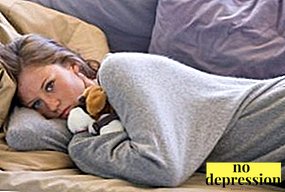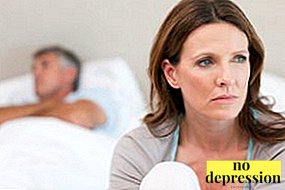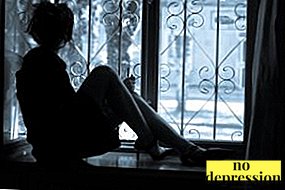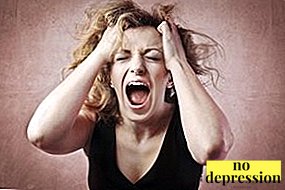Depression is one and a half times more common in women.
Main symptoms of depression in women - severely depressed mood, a sense of one’s own uselessness and worthlessness, a violation of the ability to feel joy or satisfaction, various somatic deviations, including dizziness, weakness, headaches, drops in blood pressure, tachycardia.
Basic information

Depression - mental illnesswhich is considered one of the most common mental disorders in the world.
About 40-60% of people who committed suicide suffered from depression.
And a quarter of women living in developed countries faced this disease at least once in their life.
Some people tend to treat depression disparagingly, underestimate her danger and consider that any person can cope with it on her own, and if he cannot, then he is most likely just lazy or loves to be pityed.
This opinion is especially common in those who have never encountered real depression and equates it with a bad mood.
However, it’s wrong to treat a serious mental disorder this way: people with depression in most cases unable to handle it myself due to lack of internal resources, therefore, they need help from outside.
In women, depression is diagnosed more often than in men. Also, women often try to commit suicide, but, according to statistics, successful suicides in men more.
About 90% of depression associated with external factors: psycho-emotional shocks, chronic stress.
Against the background of this disease, other mental disorders may also develop: anxiety disorder, obsessive-compulsive and panic disorder, various personality disorders.
What is depression and what happens to women? Find out from the video:
Causes and risk group
Why does depression occur in women? The main causes of depression:
 Negative external factors: excessive mental or physical exertion, hunger, illness or death of close people, divorce, scandals with a partner, parents or friends, caring for a person with severe disability, own serious illness (every fourth person with cancer suffers from depression, at least 20% of HIV infected people have this disorder), a child with physical or mental defects, loss of work, financial problems.
Negative external factors: excessive mental or physical exertion, hunger, illness or death of close people, divorce, scandals with a partner, parents or friends, caring for a person with severe disability, own serious illness (every fourth person with cancer suffers from depression, at least 20% of HIV infected people have this disorder), a child with physical or mental defects, loss of work, financial problems.- Achieving a meaningful goal. Some people devote to achieving certain goals for decades. And many of them, when they get what they want, develop depression because they feel that they have lost the meaning of life.
- Personality Features. Sensitive women with low stress tolerance are more likely to suffer from depression.
- Genetic predisposition. The likelihood of developing this disorder increases if there are people among close relatives who have suffered or are suffering from them.
- Hormonal changes. During life, a woman's body undergoes various changes that affect her mood and resistance to stress.
They are especially pronounced in puberty, after childbirth and during menopause.
- Brain damage of different nature. These include head injuries, strokes, encephalopathic changes (toxic, dyscirculatory, radiation, metabolic).
Women are at risk:
- in the organism of which natural hormonal changes occur (puberty, menopause, pregnancy, the first few months after the birth of a child);
 which have somatic diseases such as gastric ulcer, chronic respiratory failure, chronic cardiovascular failure, coronary artery disease, diabetes mellitus of the first or second type, cirrhosis, systemic lupus erythematosus;
which have somatic diseases such as gastric ulcer, chronic respiratory failure, chronic cardiovascular failure, coronary artery disease, diabetes mellitus of the first or second type, cirrhosis, systemic lupus erythematosus;- suffering from alcohol or drug addiction;
- living in large cities.
What hormonal disorders can cause depression? The relationship of menopause and depression:
At different ages
There are several age periods when the probability of developing depression is quite high:
- From 15 to 25 years. Approximately 20-40% of women in this age period are faced with depression, which is associated with hormonal changes and maturity, entailing a lot of difficulties. A woman makes decisions, including those that seriously affect her future life, learns, moves away from her parents, starts working, solves the problems associated with life, material difficulties, social interactions.
Depression that occurred at this time can significantly complicate the adaptation of a young woman in society.
- After forty years. This period is called the middle age crisis. Half of the life has passed, children, if they exist, are usually quite old enough and do not need constant maternal control. The first age-related diseases manifest themselves, which are also capable of severely undermining the psycho-emotional state of a woman. She is forced to reconsider her life values and priorities, to look at life and on herself from other sides, to look for something that will become her inner support in the future. Also, phobias have an impact: if a woman has carcinophobia or thanatophobia, they are significantly enhanced.
 In 50 years. During this period, climacteric changes begin to manifest themselves. A woman becomes more sensitive, her mood often changes, she is more irritable than usual, crying more often. Therefore, even moderate life troubles, coupled with the feeling that old age is not far off, can cause depressive symptoms.
In 50 years. During this period, climacteric changes begin to manifest themselves. A woman becomes more sensitive, her mood often changes, she is more irritable than usual, crying more often. Therefore, even moderate life troubles, coupled with the feeling that old age is not far off, can cause depressive symptoms.- After 65 years. Depression in this period occurs in 30% of people and seriously worsens their quality of life, in which there are enough difficulties without mental problems. Many older women over the age of 60-65 change their character, various vascular disorders develop, affecting the brain, they notice that their cognitive abilities (memory, thinking, attention) are not as good as they used to be, which makes them sad.
If a woman is lonely or her family treats her badly, the likelihood that she will get depressed increases significantly.
Classification
The main types of depression:
- Big. Also called a major depressive disorder. With this type of depression, there is a whole range of severe symptoms: severe depression, difficulty concentrating, a sharp increase or decrease in weight, thoughts of death and suicidal tendencies, lethargy, loss of interest in hobbies, and sleep disorders.
 Small: A woman has at least two symptoms inherent in MDD, and lasts more than two weeks.
Small: A woman has at least two symptoms inherent in MDD, and lasts more than two weeks.- Atypical. In addition to the standard depressive symptoms, there is also drowsiness, increased appetite, weight gain.
- Recurrent. Periods of exacerbation (usually lasting several days) are replaced by periods without signs of depression.
Separately, the following types of depression can be distinguished:
- Postpartum. It develops after the birth of the child, its development is largely due to the mother’s difficulties in caring for the newborn and pronounced hormonal changes.
- Postwedding. It arises after marriage and is usually connected with the fact that the woman’s expectations are not met: she understands that living together with a man is not at all as pleasant as she imagined, and everything is not at all like in fairy tales, where the couple lives happily ever after.
Also there are the following severity depression:
- easy;
- moderate;
- heavy;
- severe, with which psychotic symptoms are observed.
Most of the depression refers to psychotic, or exogenous, that is, those whose occurrence is due to external factors.
There are also endogenous depressions that develop under the influence of the individual characteristics of the organism and the personality of the woman.
Symptoms and signs

Depression rarely occurs rapidly; in most cases she develops slowly enoughand her neurosis can be a harbinger.
First signs depression:
- loss of motivation;
- depressed mood;
- irritability;
- increased fatigue;
- desire to be alone;
- decrease in interest in sex.
Others appear later. the symptoms:
- lethargy, apathy;
- tearfulness;
- feeling of depression becomes stronger, sometimes reaching extreme points;
- the woman feels worthless;
- the future seems dark and void of prospects;
- performance deteriorates significantly;
- life seems meaningless;
- pursuing the feeling that there is not enough strength for anything;
- sleep disorders and various somatic disorders are observed;
- cognitive abilities weaken and ability to learn decreases;
- weight falls or increases;
- there are thoughts, intentions of a suicidal character, even attempts to commit suicide;
- the cycle becomes irregular, until the disappearance of menstruation.

If, in addition to depression, the woman has other mental disorders, the symptoms will be blurred and may include anxiety, panic attacks, obsessions and compulsions.
In some cases, depression is hidden and manifests itself only by somatic disorders, so the woman goes to doctors unsuccessfully, and they consistently do not find any serious diseases.
Danger
The main dangers of depression are:
- Suicide The feeling of hopelessness can push a woman to the desire to interrupt their existence.
And even if suicide attempts are unsuccessful, they are capable of leaving serious consequences, even disability.
- Problems associated with the realization of oneself in life. A depressed woman cannot be a good worker, is not able to study well, fully communicate with others, so she can be fired, or she herself is dismissed, because she no longer sees the meaning of what she is doing and does not feel that she has the strength.
- Somatic diseases. Depression aggravates the course of chronic diseases that a woman has and causes new ones.
- Negative impact on children. If a woman has children, they need emotional support, communication, warmth, and she cannot give them because of her condition. In the future, this may adversely affect their psycho-emotional development, cause a feeling of uselessness.
Diagnostics

A woman who noticed signs of depression, It is important to consult a general practitioner and list your symptoms to get referrals to more narrow specialists.
She will also need to go through a series of studies, depending on her symptoms, to make sure that her problem is not related to serious somatic diseasessuch as brain tumors, tumors in the thyroid gland, disturbances of hormone levels.
If somatic diseases are absent, the woman passes special tests that make it possible to determine the level of depression, speaks with a psychotherapist and a psychiatrist.
If necessary, she is given additional tests to eliminate mental illnesscapable of giving similar symptoms.
Treatment
How and what to treat female disease? After the diagnosis, the woman is selected medication, which may include:
- Antidepressants. Examples: Fluoxetine, Coaxil, Paroxetine. Eliminate the symptoms of depression, if they are chosen correctly. If the classic treatment regimen did not show results, your doctor may prescribe several antidepressants at once.
When moderate severity is often prescribed herbal antidepressants based on Hypericum (Hypericin, tinctures).
- Atypical antipsychotics. Increase mood, have a stimulating effect on the nervous system, eliminate apathy. Examples: olanzapine, risperidone.
- Lithium preparations. Reduce impulsiveness, reduce the likelihood of committing suicide, increase the effectiveness of basic drug therapy. Examples: Micalite, lithium carbonate.

Psychotherapy with depression is extremely important, because in its absence, the improvement of the patient’s condition will be observed only during periods of medication.
In the treatment of depression, cognitive-behavioral psychotherapy shows high performance. As additional effective following psychotherapeutic areas:
- art therapy;
- hypnotherapy;
- gestalt therapy.
Positively affects the patient's condition non-pharmacological treatment: massage, light therapy, hydrotherapy, therapeutic exercise, aromatherapy.
Practical recommendations
What to do: how to relieve a woman of depression? Independently to cure depression is difficult, but some improvements can be made if the disease is moderate. It can also be useful for women who are already undergoing basic treatment.
Recommendations:
- Try to be more often in the fresh air, read books, try to find new hobbies and be engaged in what causes at least moderate positive feelings.
- Inaction is capable significantly worsen the condition with depression. Lying in bed will inevitably lead to the fact that you begin to roll negative thoughts in your head monotonously. Also, the lack of promotion in important activities will make you feel worse. But since the forces of depression are very few, it is unlikely that you can force yourself to do all the work.
Therefore, we must try to do the work in parts. Gradually, the first results will appear, and this may have a positive effect on your well-being.
- Physical activity able to improve well-being, as training triggers the production of pleasure hormones. Even if the internal resources are very small, you can try to persuade yourself to a short workout with light exercises.
Books that can help deal with female depression:
 “Wellbeing. New Sentiment Therapy, Byrnes David. The book describes in detail the mechanism of the onset of symptoms of depression and provides methods for dealing with them.
“Wellbeing. New Sentiment Therapy, Byrnes David. The book describes in detail the mechanism of the onset of symptoms of depression and provides methods for dealing with them.- “A Cure for Depression”, Mihrdat Madatyan. The book allows you to analyze your own well-being and find a way out of depression.
- “The crisis of forty”, Belozub Galina. Psychological recommendations to women who have crossed the forty-year milestone.
How to deal with depression in women without drugs? Useful advice in this video:
Prevention
Preventive recommendations:
- try to eat well, make sure that the diet contains all the necessary vitamins and trace elements (for example, vitamin B12 deficiency can cause depression);
- often walk in the fresh air and engage in what brings pleasure;
- do not allow toxic people into your life;
- Avoid stressful situations whenever possible.
If you start treating depression in time, you can quickly eliminate key symptoms and avoid complications.
How to get out of depression? The mood of academician G. Sytin “Healing from depression! For women":

 Negative external factors: excessive mental or physical exertion, hunger, illness or death of close people, divorce, scandals with a partner, parents or friends, caring for a person with severe disability, own serious illness (every fourth person with cancer suffers from depression, at least 20% of HIV infected people have this disorder), a child with physical or mental defects, loss of work, financial problems.
Negative external factors: excessive mental or physical exertion, hunger, illness or death of close people, divorce, scandals with a partner, parents or friends, caring for a person with severe disability, own serious illness (every fourth person with cancer suffers from depression, at least 20% of HIV infected people have this disorder), a child with physical or mental defects, loss of work, financial problems. which have somatic diseases such as gastric ulcer, chronic respiratory failure, chronic cardiovascular failure, coronary artery disease, diabetes mellitus of the first or second type, cirrhosis, systemic lupus erythematosus;
which have somatic diseases such as gastric ulcer, chronic respiratory failure, chronic cardiovascular failure, coronary artery disease, diabetes mellitus of the first or second type, cirrhosis, systemic lupus erythematosus; In 50 years. During this period, climacteric changes begin to manifest themselves. A woman becomes more sensitive, her mood often changes, she is more irritable than usual, crying more often. Therefore, even moderate life troubles, coupled with the feeling that old age is not far off, can cause depressive symptoms.
In 50 years. During this period, climacteric changes begin to manifest themselves. A woman becomes more sensitive, her mood often changes, she is more irritable than usual, crying more often. Therefore, even moderate life troubles, coupled with the feeling that old age is not far off, can cause depressive symptoms. Small: A woman has at least two symptoms inherent in MDD, and lasts more than two weeks.
Small: A woman has at least two symptoms inherent in MDD, and lasts more than two weeks. “Wellbeing. New Sentiment Therapy, Byrnes David. The book describes in detail the mechanism of the onset of symptoms of depression and provides methods for dealing with them.
“Wellbeing. New Sentiment Therapy, Byrnes David. The book describes in detail the mechanism of the onset of symptoms of depression and provides methods for dealing with them.

